The Battle of Bay Trail-D: GIGABYTE J1900N-D3V and ASUS J1900I-C Reviewed
by Ian Cutress on October 17, 2014 10:00 AM ESTIntegrated Graphics Gaming on J1900
For our gaming analysis, we took the gaming results from the GIGABYTE J1900N-D3V to compare against other integrated graphics solutions.
F1 2013
First up is F1 2013 by Codemasters. I am a big Formula 1 fan in my spare time, and nothing makes me happier than carving up the field in a Caterham, waving to the Red Bulls as I drive by (because I play on easy and take shortcuts). F1 2013 uses the EGO Engine, and like other Codemasters games ends up being very playable on old hardware quite easily. In order to beef up the benchmark a bit, we devised the following scenario for the benchmark mode: one lap of Spa-Francorchamps in the heavy wet, the benchmark follows Jenson Button in the McLaren who starts on the grid in 22nd place, with the field made up of 11 Williams cars, 5 Marussia and 5 Caterham in that order. This puts emphasis on the CPU to handle the AI in the wet, and allows for a good amount of overtaking during the automated benchmark. We test at 1280x1024 on Low graphical settings.
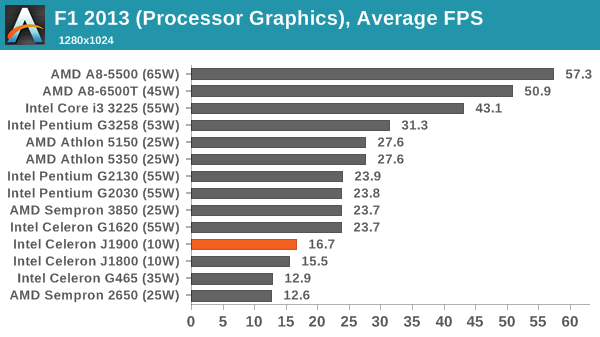
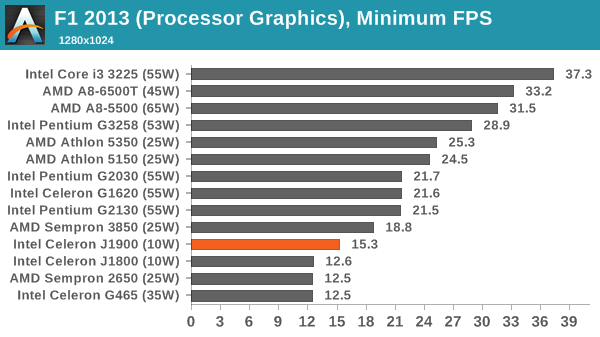
Bioshock Infinite
Bioshock Infinite was Zero Punctuation’s Game of the Year for 2013, uses the Unreal Engine 3, and is designed to scale with both cores and graphical prowess. We test the benchmark using the Adrenaline benchmark tool and the Performance (1280x1024, Low) setting, noting down the average frame rates and the minimum frame rates.
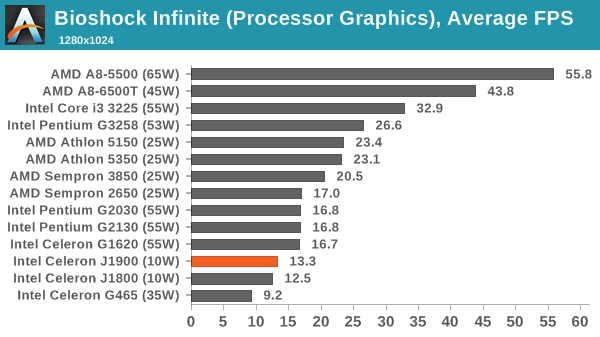

Tomb Raider
The next benchmark in our test is Tomb Raider. Tomb Raider is an AMD optimized game, lauded for its use of TressFX creating dynamic hair to increase the immersion in game. Tomb Raider uses a modified version of the Crystal Engine, and enjoys raw horsepower. We test the benchmark using the Adrenaline benchmark tool and the Performance (1280x1024, Low) setting, noting down the average frame rates and the minimum frame rates.
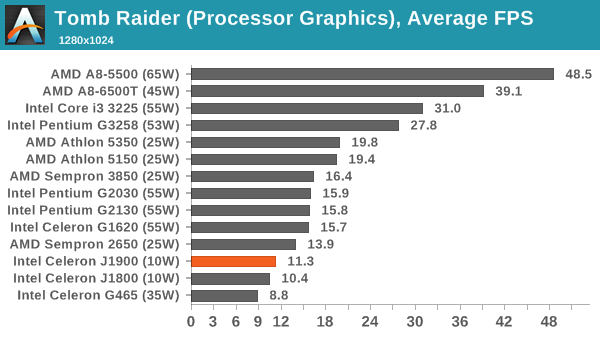
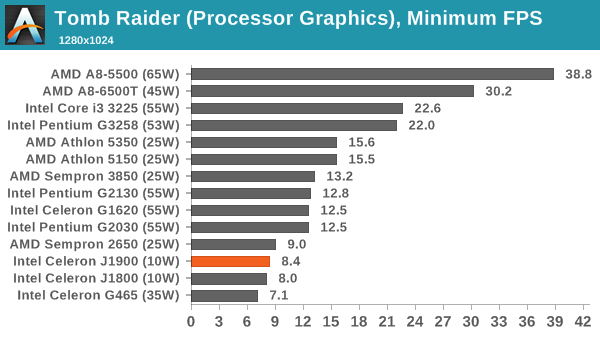
Sleeping Dogs
Sleeping Dogs is a benchmarking wet dream – a highly complex benchmark that can bring the toughest setup and high resolutions down into single figures. Having an extreme SSAO setting can do that, but at the right settings Sleeping Dogs is highly playable and enjoyable. We run the basic benchmark program laid out in the Adrenaline benchmark tool, and the Performance (1280x1024, Low) setting, noting down the average frame rates and the minimum frame rates.
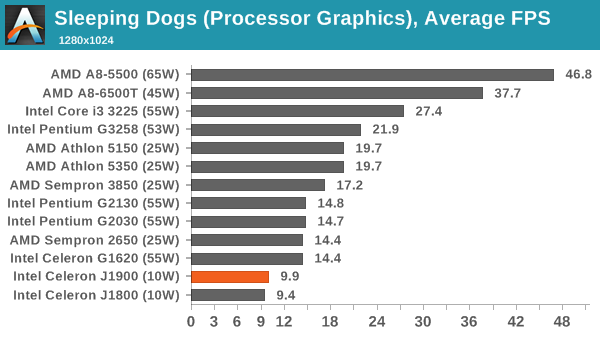
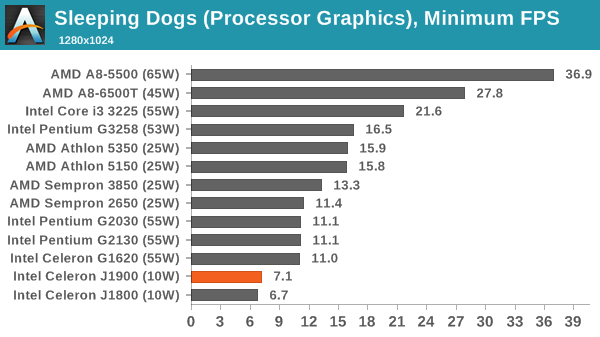
3DMark Ice Storm Ultimate















60 Comments
View All Comments
Factory Factory - Friday, October 17, 2014 - link
I recently bought the ASRock J1900-ITX for a cheap NAS/HTPC/Steam Home Streaming build, and I have to say I'm really pleased with it. It seemed like a great midpoint between the Gigabyte and Asus boards here: visual BIOS with fan controls, two USB 3.0 ports in back plus a header, DVI and HDMI both, ALC892 with optical audio out, and - this was big for the NAS part - two extra ASMedia SATA ports and a PCIe x1 slot. I stuck another ASMedia-based SATA card in the PCIe slot and shoved the whole thing in a Bitfenix Prodigy with a bunch of drives.I almost went with an AM1 build, but I knew that all my media and SHS worked fine with my Bay Trail tablet, and an Athlon 5350 and ASRock AM1H-ITX just didn't seem compelling at $50 more for the set (or even $25 more for an AM1B-ITX) and extra power consumption.
jospoortvliet - Saturday, October 18, 2014 - link
Note that unless you load you system all the time, the AM1 might actually have saved you power - idle is lower in most tests than Intel.abufrejoval - Tuesday, October 21, 2014 - link
Could you please add AM1 idle power figures?I've measured 10Watt idle power behind the Pico-PSU power supply for the GIGABYTE J1900N-D3V and 6.3 Watt idle power on the GIGABYTE GA-J1800N-D2H which is the dual core edition without the 2nd GBit port, the Renesas USB 3 hub, serial ports etc.
Top power consumption in mixed Prime95, Furmark loads including some USB peripherals was 28 Watts for the Quad and 22 Watts for the Dual.
A Cruical C300 SSD was used in all cases, which doesn't yet support the nice power saving features of the newer Crucial SSDs.
I've tried shutting down unused peripheral devices (e.g. serial ports, 2nd Gbit Ethernet) and limiting the PCIe speed to gen1 to see whether that had any measurable impact: It didn't for idle.
I've been an AMD fan for decades, but I'm also trying to stay objective.
And with regards to idle power and AMD:
While I've measured surprisingly good idle power values for my first Trinity based APU (A10-5800K) as low as 18Watts with a high-end Asus motherboard, I'm shocked that my Kavery variant (A10-7850K) won't go below 30Watts all measured at behind the PSU.
At the same time I've measured Gigabyte Brix using Intel A7-4500U CPUs (GIGABYTE BRIX GB-BXi7H-4500U) which achieved 7.5 Watts of idle power, but beat the A10-5800K on pretty much every benchmark, CPU, GPU or both while it didn't exceed 25 Watts of system consumption (vs. 100 Watts for the AMD APU).
Again I'd love to be able to report otherwise, but compute power per Watt is AMD's high-end weakness and idle power the low-end weakness. Which one is more important depends on your use case but both are currently killer criteria.
abufrejoval - Tuesday, October 21, 2014 - link
The coolest thing about the ASrock boards is that they support 16GB of DRAM!Officially BayTrail tops out at 8GB but this may turn out to be more of a typical Intel "product castration" feature than a hardware limit. I haven't actually tried this on my GIGABYTE J1900N-D3V and would be afraid, that the BIOS might still limit that board to 8GB, but I've seen reports of people using ASRock Q1900B-ITX or ASRock Q1900M (includes a physical PCIe x16 slot with x1 connectivity) with 16GB of DRAM.
mjnhstyle100x - Friday, October 17, 2014 - link
The power consumption delta is something I do not like. I rather see the idle and load instead. The idle tells me how much my "nas/htpc" system will consume while doing nothing. the load tells me what is the absolute worse it will consume. this allows me to weigh the options better on power consumption basis, not the delta as that's not what is going to matter when the system is going to be idling for prolonged periods.The power consumption delta is something I do not like. I rather see the idle and load instead. The idle tells me how much my "nas/htpc" system will consume while doing nothing. the load tells me what is the absolute worse it will consume. this allows me to weigh the options better on power consumption basis, not the delta as that's not what is going to matter when the system is going to be idling for prolonged periods.
anactoraaron - Friday, October 17, 2014 - link
I decided to flip back and forth to compare the 3770 and 3740 Bay Trail T to the Bay Trail D... It's surprising how well the lower powered T fares when compared to the D.rootheday3 - Friday, October 17, 2014 - link
Table on page 1 says Baytrail graphics has 6 EUs => not correct; Baytrail only has 4EUs.duploxxx - Friday, October 17, 2014 - link
poor poor Bay-trail GPU, only half the performance of the competing AMD part. No wonder Intel lost money in that segment. You would expect that in 2014 Intel would understand that graphical is actually what you see and use these days. Even CPU it is not faster. This is again a moment like the brazos part, this was also way better then the atom, yet the djingle and oem designs forced everybody to buy that peace of crap because there were only few brazos designs.pitty that we dont see amd mullin tablets for x86, no those OEM yet have to get money to be convinced from intel because they know they get poor cpu designs............... and then complain the market does not accept these tablets, i have a crapy atom tablet here which now is just a radio station, no added value at all for anything else
consumers are losing as usual.
silverblue - Friday, October 17, 2014 - link
Apparently, the A6-6310 has a 15W TDP and a much faster GPU, using just over half the power of the 5350. Its base clock is 250MHz lower at 1.8GHz, but has a 2.4GHz turbo. The A5 is also enabled this time around.I'd really like to see one of these go through some thorough tests on AT; could make for a very interesting little machine. It's just a shame that they have gone for faster RAM over a dual channel controller, but the controller itself uses less power than before which is helpful.
abufrejoval - Tuesday, October 21, 2014 - link
Running PC games on the box isn't a lot of fun fore sure, but running Android x86 gave quite another picture: The GPU may not be able to hold water against PC GPUs but it's quite powerfull enough for any Android game and benchmark that I tried, at least at 1080p.Tons more CPU power than the Snapdragon 800 on my Galaxy Note 3 and GPU performance in the same region.
Sure the Snapdragon would never dream of burning 10Watts of power for that performance, but the GIGABYTE GA-J1900N-D3V isn't meant to be carried in your pocket. As high-end HDMI stick alternative, it doesn't do too badly.
Nor as a Windows or Linux desktop for office work.
With Lollipop we might see these use cases merge and full desktop office suites like Softmaker's will do the transition.